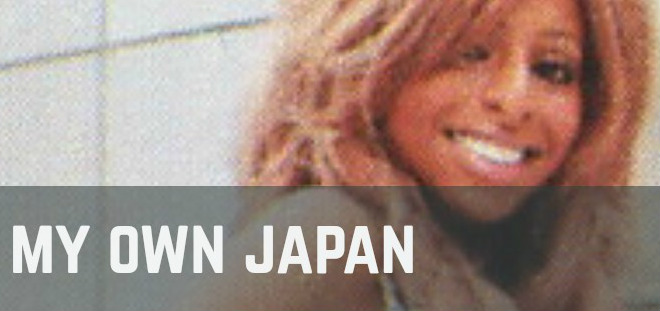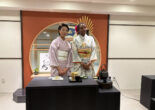
My Own Japan: Life as a Gyaru and Working in Shibuya 109
We all have a story of how we ended up in Japan. Whether it be love, studies, martial arts, calligraphy, animation, swordmaking, you name it, there’s something that attracted us to this island country. Here is my story.
It begins perhaps much like the stories of anyone interested in all things Japan. It was 2002 and I started my senior year of high school at as a transfer student. I came from a school with a population of less than 500 to being a student in a mega-school of nearly 2000 students. I was lost, both literally and figuratively.
My escape from the confusion was the world of Japanese animation and music. Hoping a like-minded fan would take notice, my binders and notebooks were plastered with clippings of doe-eyed anime characters and androgynous J-Rockers whose makeup skills would rival those of even the most popular makeup gurus of Instagram today.
I had even taken up the task of studying Japanese independently so that I would be able to read manga, Japanese comic books, and watch and my favorite animated series without relying on translations. (Unbeknownst to me, it was very naive approach as 15 years later, even with 10 years residency in Japan, I find myself adding new words to my vocabulary nearly everyday.)
Through this escapist hobby, I made it through my final year of high school and went to college. I took Japanese language classes and toyed with the idea of doing a study abroad. Now, at that time in my life, I hadn’t even been on an airplane, yet there I was, pondering over books in my dorm room, thinking about leaving the US.
I’m from the southern US, South Carolina to be exact, and my college was located in a town in North Carolina. I had taken one trip to NYC and another to LA as well, but I was a Southern girl, born and raised. Nevertheless, I managed to make my dream come true. I was selected to study at International Christian University.
Impressions of Tokyo
Coming from my background, being in a city like Tokyo was absolutely overwhelming. I was intoxicated by the sights and sounds. A dizzying train and subway system that could take me anywhere in Japan. An endless line of buses, cars, and taxis. People and bicycles performing an amazing synchronized dance as they moved without bumping into one another.
My fascination was particularly with the women tottering around in precariously high heels, skirts of dangerous lengths, and garish makeup. It was the summer of 2004, August to be exact. I had arrived right in the middle of Tokyo’s humid season. Yet, there they were, fashionable ladies with nary a bead of sweat on their immaculately powdered faces… and then there was me, a sweaty, frizzy haired, makeup-free mess in jeans and a t-shirt.
They were gyaru, as I would later come to learn. These fashionable ladies with their tanned skin, bleached hair, and bejeweled nails made Shibuya their kingdom, and their palace was the famed department store, Shibuya 109; a silvery, cylindrical shaped shopping mecca that glistened in the sun.
A Lasting Impression
 Stepping inside that building, it was a cacophony of trance music, rap music, and “Irasshaimase,” a greeting commonly heard in Japanese shops and eateries to formally welcome customers. Each store, it seemed, was dedicated to a different fashion genre. But, no matter where I looked, all staff looked like they stepped out of a magazine. I had found my calling- I wanted to be like them.
Stepping inside that building, it was a cacophony of trance music, rap music, and “Irasshaimase,” a greeting commonly heard in Japanese shops and eateries to formally welcome customers. Each store, it seemed, was dedicated to a different fashion genre. But, no matter where I looked, all staff looked like they stepped out of a magazine. I had found my calling- I wanted to be like them.
Purikura, photos taken in a special machine that allows users to decorate, print, and share amongst one another.
I spent my year abroad eschewing the “safe” Tokyo areas of nearby Kichijoji frequented by other ICU students and went out frequently to Shibuya. My Japanese, while not up to textbook standards, certainly mimicked that of my overly tanned friends, as did my fashion sense. Before I realized it, my year abroad was over.
Returning to the US, I couldn’t forget my time as a student/gyaru. I knew I had to find a way back to Japan, back to the bustling metropolis of Tokyo. But how? After much research, it came to my attention that the best bet was to teach English.
Finding a Job in Japan
If I taught English, how could I wear my gyaru clothes? What about the hairstyles and makeup? I decided that teaching was not for me. There had to be another way, and I had two more years of college to develop a plan. Pressing my luck, I applied to and was accepted to Sophia University’s graduate program. I thought that the freedom that I had as a study abroad student could be replicated as a grad student.
However, when I returned to Tokyo in 2007, I made a decision that undoubtedly changed my life. A stop at Shibuya 109 check out the latest fashions prompted me to question my path. What if, instead of being a grad student…What if I worked here? I thought. I could always be a graduate student, but working in Shibuya 109, that’s something I can only do now.
As Shibuya 109, or maru-kyuu as it is called colloquially, featured myriad of shops with varying fashion genres. At this time in Japanese fashion, working at Shibuya 109 as a charisma shop clerk was a position of prestige. These were the most fashionable girls in all of Tokyo, featured in fashion magazines and invited to party among established models at the most happening clubs. Some charisma sales clerks even managed to start up their own clothing lines.
Being a foreigner with a basic command of Japanese, I knew that working in Shibuya 109 would be a challenge. I had a prepaid cellphone and a bank account which I opened when I was a student, so with the technical details out of the way, I was able to focus solely on my challenge.
I had to prove that I could “walk the walk and talk the talk.” I made an investment in several fashion magazines, revamped my makeup routine, and invested in a few “in” pieces.
Finding Myself, Dressing Myself
I looked for a brand that I felt that suited me best. Staff at the stores in Shibuya 109 were required to wear the clothes solely from their brand on a daily basis. The question for myself was, “Who do I want to be?” After years of feeling out of place, this was my chance to reinvent myself, to take control of the narrative for my new life in Tokyo.
There were so many fashion trends in Tokyo. Did I want to be lolita, a genre that invoked the Victorian era? Perhaps a hime-gyaru dressed as a princess with large, teased hair? Exploit my African-American heritage and legitimize the hip hop b-gyaru movement by being an ambassador for one of its largest brands?

A scan from a magazine, this was taken a year after I started at Shibuya 109 with the iconic building in the background.
I settled on Galesville as its staff represented nearly all of the major fashion movements at the time. The manager wore all black, with a lace-up bustier and black flared trousers with a wide studded leather belt slung around her hips, her hair long and black, parted down the middle. The assistant manager was a petite woman with more piercings in each ear than fingers on my two hands, rainbow micro braid extensions, wild color contacts, and a shy demeanor. Of the other two staff, one was a heavily tanned and slim b-gyaru, the other was a bona fide gyaru straight out of high school.
Learning the Ropes
My company supplied me with a training manual that detailed how I should perform my duties as a brand ambassador at its flagship store. Everything – a master list of Japanese honorifics, how to greet customers, answering the phone, ordering products from suppliers – was described meticulously in that manual. Shibuya 109 also held a training session in which all new employees were required to attend so that the image of Shibuya 109 remained a place of trendy and polite staff.

Taken with my company’s shachou, or president, after the renewal opening of our Shibuya 109 store.
In addition to these training manuals and workshops, I studied the Japanese phrases written in mail order catalogues to get a grasp on how to describe in details a particular item of clothing to a customer. I used my keitai, cell phone, to record myself talking in Japanese to perfect my flow and pronunciation.
As I began to develop my own way of approaching customers, my monthly sales amount gradually increased. I broke into the Top 5 of the company-wide seller list, a list dominated by the managers and assistant managers of the Shibuya, Shinjuku, and Ueno stores.
 In turn, was given more responsibilities, which I enthusiastically accepted. I could now relegate menial tasks like dusting and taking out the trash to new staff while I focused on writing daily sales reports, conducting stock inventory, opening the store, and closing the register at night.
In turn, was given more responsibilities, which I enthusiastically accepted. I could now relegate menial tasks like dusting and taking out the trash to new staff while I focused on writing daily sales reports, conducting stock inventory, opening the store, and closing the register at night.
How I typically styled myself outside of working hours.
The Fall of Japanese Fashion Brands
But as all good things do, my time as a charisma sales clerk had eventually run its course. Gyaru were falling out fashion for more subdued styles. Around 2009-2010, fast fashion swept Japan. Pricey, domestic Japanese brands were now competing with inexpensive pieces from international powerhouses like H&M and Forever 21. Uniqlo, of all places, became…fashionable.
 Garrish blonde hair and an overly highlighted face was replaced with brown hair and a simple makeup routine as gyaru fell out of fashion.
Garrish blonde hair and an overly highlighted face was replaced with brown hair and a simple makeup routine as gyaru fell out of fashion.
What domestic brands that didn’t fall, merged together or choose to sell articles of clothing made in China to cut costs. My company choose to cut back on producing clothing in Japan in favor of selling such pieces. Becoming surrounded by clothes that could be found in any store, I felt that the brand was losing its individuality. I realized that my journey was coming to an end.
Underneath It All – A Reflection of Me
Years later, as I reflect on my experience, it was a journey filled with hardships and extreme budgeting, but the experience made me into who I am today. I owe my fluency in the Japanese language and my independence to this experience.
Related Articles
Warning: Undefined array key "sfsi_threadsIcon_order" in /home/veremosglobal/tokyoroomfinder.com/public_html/blog/wp-content/plugins/ultimate-social-media-icons/libs/controllers/sfsi_frontpopUp.php on line 165
Warning: Undefined array key "sfsi_blueskyIcon_order" in /home/veremosglobal/tokyoroomfinder.com/public_html/blog/wp-content/plugins/ultimate-social-media-icons/libs/controllers/sfsi_frontpopUp.php on line 170
Warning: Undefined array key "sfsi_bluesky_display" in /home/veremosglobal/tokyoroomfinder.com/public_html/blog/wp-content/plugins/ultimate-social-media-icons/libs/controllers/sfsi_frontpopUp.php on line 266



